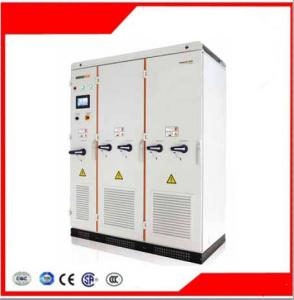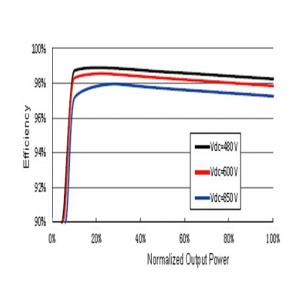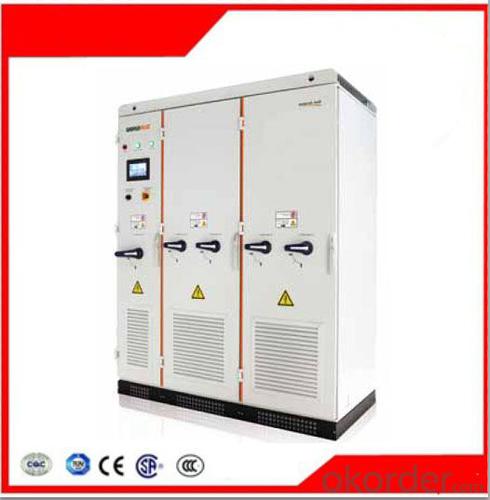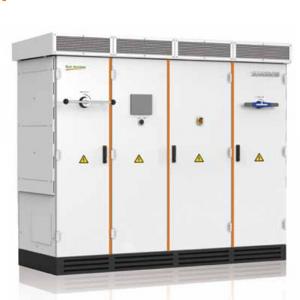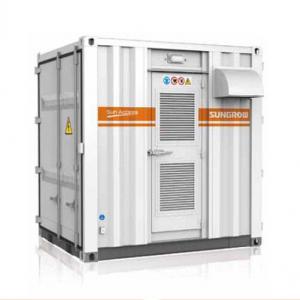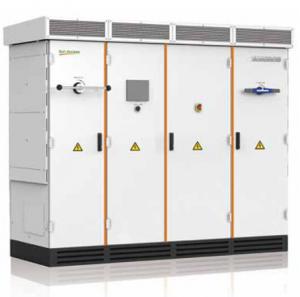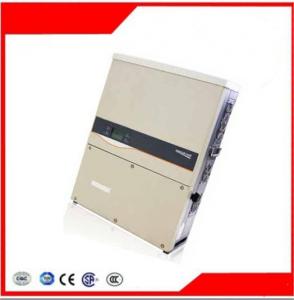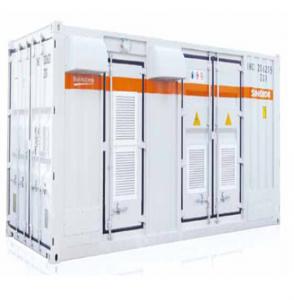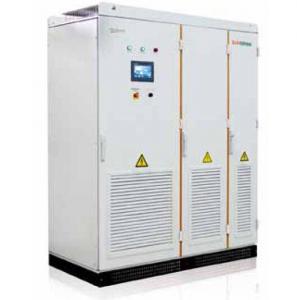Photovoltaic Grid-Connected Inverter SG500MX-M
- Loading Port:
- China Main Port
- Payment Terms:
- TT or LC
- Min Order Qty:
- 50 unit
- Supply Capability:
- 1000 unit/month
OKorder Service Pledge
OKorder Financial Service
You Might Also Like
1. Structure of Photovoltaic Grid-Connected Inverter SG500MX-M Description
A solar inverter, or PV inverter, or Solar converter, converts the variable direct current (DC) output of a photovoltaic (PV) solar panel into
autility frequency alternating current (AC) that can be fed into a commercial electrical grid or used by a local, off-grid electrical network.
It is acritical BOS–component in a photovoltaic system, allowing the use of ordinary AC-powered equipment. Solar inverters have
special functions adapted for use with photovoltaic arrays, including maximum power point tracking and anti-islanding protection.
Suitable for 50Hz/60Hz grid, could be used in Asia, North America and Europe.
2. Main Features of the Photovoltaic Grid-Connected Inverter SG500MX-M
• Advanced three-level circuit structure improves product's performance
• 4-MPPT, wide MPP voltage range
• Modular design, long operation time
• Film bus capacitors with long lifespan
• Rotating the modules in use extends the inverter's lifespan
• Inverter sleeping at night doubles the PCB lifespan
• Elevated cooling performance and protection level ensures reliable operation
• Less THD, more grid-friendly
• Less common-mode interference, more environment-friendly
• Compatible with two-winding transformer
• Flexible setting of 1 to 4 MPPT
• Reactive compensation on asymmetric power grid
• Direct parallel connection at low voltage side, easy to expand the capacity
• Comprehensive modular design
• All components front-maintenance
• Draw-type modules, service friendly design
• Less THD, more grid-friendly
• Less common-mode interference, more environment-friendly
• Compatible with two-winding transformer
• Flexible setting of 1 to 4 MPPT
• Reactive compensation on asymmetric power grid
• TÜV, CE, CGC certification, compliance with BDEW
3. Photovoltaic Grid-Connected Inverter SG500MX-M Images
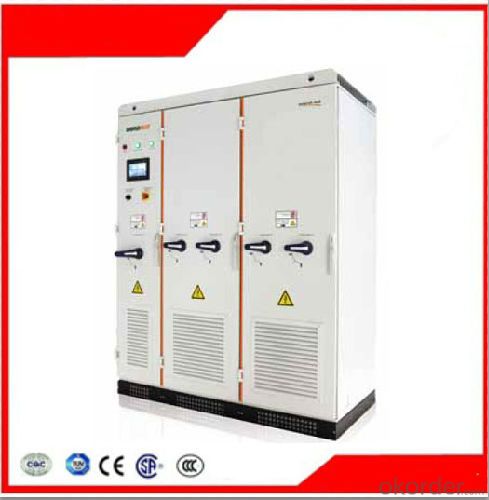
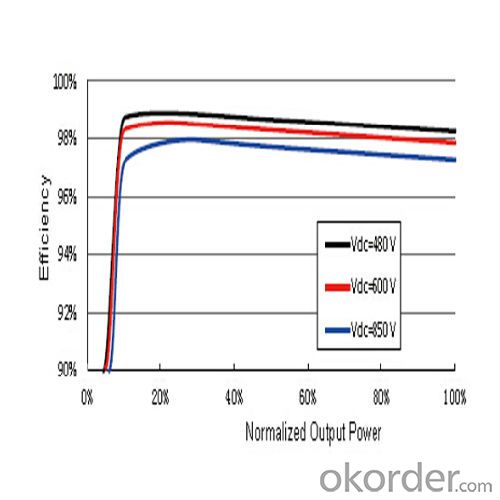
4. Photovoltaic Grid-Connected Inverter SG500MX-M Specification
Input Side Data |
|
Max. PV input power | 560kW |
Max. PV input voltage | 1000V |
Start voltage | 520V |
Min. operation voltage | 480V |
Max. PV input current | 1064A |
MPP voltage range | 480~850V |
No. of MPPTs | 1, 2, 3, 4 |
No. of DC inputs | 2 x 4 |
Output Side Data |
|
Nominal AC output power | 500kW |
Max. AC output apparent power | 550kVA |
Max. AC output current | 1018A |
THD | <3%(Nominal power) |
Nominal AC voltage | 315V |
AC voltage range | 252~362V |
Nominal grid frequency | 50/60Hz |
Grid frequency range | 47~52 / 57~62Hz |
Power factor | >0.99@default value at nominal power, adj. 0.9 overexcited~0.9 underexcited |
Isolated transformer | No |
DC current injection | <0.5 % In |
Efficiency |
|
Max. efficiency | 98.80% |
European efficiency | 98.60% |
Protection |
|
Input side disconnection device | DC load switch |
Output side disconnection device | AC load switch |
DC overvoltage protection | Yes |
AC overvoltage protection | Yes |
Grid monitoring | Yes |
Ground fault monitoring | Yes |
Overheat protection | Yes |
Insulation monitoring | Yes |
General Data |
|
Dimensions(W×H×D) | 1606×2034×860mm |
Weight | 1400kg |
Operating ambient temperature range | -30~+55℃ |
Night power consumption | <100W |
External auxiliary supply voltage | 220V, 8A |
Cooling method | Temperature controlled aircooling |
Ingress protection rating | IP21 |
Allowable relative humidity range | 0~95% no condensing |
Max. operating altitude | 6000m(>3000m derating) |
Fresh air consumption | 5575 m³/h |
Display | Touch screen LCD |
Communication | RS485/Modbus, Ethernet |
5. FAQ of Photovoltaic Grid-Connected Inverter SG500MX-M
Q1. What is the difference between inverter and solar inverter?
A1. Inverter only has AC inpput, but solar inverter both connect to AC input and solar panel, it saves more power.
Q2. What is the difference between MPPT&PWM?
A2. MPPT has higher efficiency, it can track the max power point and won't waste energy.
- Q: Can a solar inverter be used in areas with high levels of electrical noise or interference?
- In areas with high levels of electrical noise or interference, a solar inverter can indeed be utilized. However, it is crucial to verify that the solar inverter is specifically designed and equipped to handle such conditions. Some contemporary solar inverters come with built-in features and technologies that aid in minimizing electrical noise and interference. These features encompass advanced filtering, shielding, and surge protection mechanisms. In addition, employing proper grounding and installation techniques can further diminish the impact of electrical noise and interference on the solar inverter's performance. To ensure compatibility and optimal performance in high-noise environments, it is recommended to seek advice from a professional or the manufacturer of the solar inverter.
- Q: What is the role of voltage regulation in a solar inverter?
- The role of voltage regulation in a solar inverter is to ensure that the voltage output from the solar panels is converted and maintained at a stable and appropriate level for efficient and safe operation of electrical devices or for grid connection. This regulation helps to optimize the performance of the solar inverter and prevents voltage fluctuations that could potentially damage or disrupt the functioning of connected equipment.
- Q: What certifications should I look for when choosing a solar inverter?
- When choosing a solar inverter, it is important to look for certifications such as UL 1741, which ensures the inverter meets safety and performance standards. Additionally, certifications like IEEE 1547 and IEC 61727 validate the inverter's compliance with grid interconnection requirements.
- Q: How does a solar inverter handle grid faults and disturbances?
- A solar inverter handles grid faults and disturbances by constantly monitoring the grid voltage and frequency. In case of a fault or disturbance, the inverter immediately disconnects from the grid to ensure safety and protect itself from damage. It then goes into a standby mode until the grid stabilizes. Once the grid is back to normal, the inverter reconnects and resumes normal operation, ensuring seamless and uninterrupted power supply from the solar panels.
- Q: How long do solar inverters typically last?
- Solar inverters typically have a lifespan of around 10 to 15 years. However, the actual longevity can vary depending on factors such as the quality of the inverter, maintenance, and environmental conditions.
- Q: How does a solar inverter handle voltage and frequency regulation?
- A solar inverter handles voltage and frequency regulation by converting the direct current (DC) generated by solar panels into alternating current (AC) that matches the utility grid's voltage and frequency. It achieves voltage regulation by constantly monitoring the grid voltage and adjusting the inverter's power output accordingly. Frequency regulation is achieved by synchronizing the inverter's output frequency with the grid frequency, ensuring a stable and consistent power supply.
- Q: Can a solar inverter be used with a solar-powered refrigerator?
- Yes, a solar inverter can be used with a solar-powered refrigerator. The solar inverter is responsible for converting the direct current (DC) generated by the solar panels into alternating current (AC) that can be used to power appliances like a refrigerator.
- Q: Can a solar inverter be used for both grid-tied and off-grid systems?
- Yes, a solar inverter can be used for both grid-tied and off-grid systems. However, it is important to note that there are different types of solar inverters designed specifically for each system. Grid-tied inverters are designed to convert DC power generated by solar panels into AC power and feed it into the grid, while off-grid inverters are designed to convert DC power into AC power for use in standalone systems not connected to the grid.
- Q: Can a solar inverter be used with a solar-powered waste management system?
- Yes, a solar inverter can be used with a solar-powered waste management system. A solar inverter is used to convert the direct current (DC) electricity generated by solar panels into alternating current (AC) electricity that can be used to power various appliances and systems. In the case of a solar-powered waste management system, the solar inverter would be an essential component to convert the DC power generated by the solar panels into the AC power required to operate the waste management equipment.
- Q: Can a solar inverter be used in areas with high electromagnetic radiation?
- Yes, a solar inverter can be used in areas with high electromagnetic radiation. However, it is important to consider the specific requirements and limitations of the inverter as some models may have different tolerance levels for electromagnetic interference. It is recommended to consult the manufacturer's specifications or seek professional advice to ensure proper functioning and safety in such environments.
Send your message to us
Photovoltaic Grid-Connected Inverter SG500MX-M
- Loading Port:
- China Main Port
- Payment Terms:
- TT or LC
- Min Order Qty:
- 50 unit
- Supply Capability:
- 1000 unit/month
OKorder Service Pledge
OKorder Financial Service
Similar products
Hot products
Hot Searches
Related keywords
